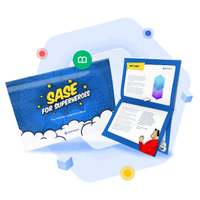The Scoop on SASE – The converging cloud security footprint
Deconstructing the complexities of SASE.

Organisations are investing heavily in broadening their network connectivity capabilities to ensure their data is accessible to the right people at the right times. For those pursuing a cloud-based, highly connected, and agile business model, ensuring proper access to data and systems in this way is absolutely essential for organisational success.
Along with greater connectivity there also comes a need for network and data security that delivers protection from the risks associated with increasingly complex infrastructures. Threats ranging from data leakage and misconfigurations to rogue employees can become parts of any complex cloud and network ecosystem when the proper protections are not put in place.
This is where the concept of SASE enters the conversation. An acronym created by Gartner, Secure Access Service Edge (SASE) is being used to describe the consolidation of network and security tools into single solutions or platforms. This pairing ensures both effective and secure access to organisations’ IT resources.
SASE for Superheroes eBook: How SASE Is Transforming Network Security
Get our SASE for Superheroes eBook and discover how to combat tool sprawl and secure your remote workforce from outside threats post-pandemic. Radically simple cybersecurity. Learn why organizations are rapidly embracing SASE as part of their long-term security strategy plan.
However, this combination of security technologies (including CASB, SWG, ZTNA, DNS Protection, and FWaaS) with WAN technologies (like SD-WAN) is quite multifaceted and can become somewhat dizzying. As such, helpful details on these converging technologies can be found below.
CASB - A Cloud Access Security Broker (CASB) is a policy enforcement point that delivers data and threat protection in the cloud and on any device, anywhere. There are three requirements for a CASB vendor, including visibility and clean-up after high-risk events, proactive security that prevents high risk events from happening in the first place, and zero-day protection from known and unknown data leakage risks and malware threats.
Corresponding to the above, there are three types of CASBs. First, there is the API-only CASB which delivers only reactive visibility. Such CASBs use API access to SaaS apps to remediate after data-leakage events. Next, there is the multi-mode first-gen CASB that delivers both after-the-fact visibility and proactive security, but not zero-day protection. Such CASBs offer only signature-based protection for known malware and known data leakage paths on a fixed set of applications. Finally, the multi-mode next-gen CASB delivers visibility, security, and zero-day protection. Such CASBs dynamically adapt to deliver protection for known and unknown data leakage risks and malware threats on any app.
Emphasis on mobility
Secure Web Gateway (SWG) – SWGs deliver URL categorisations, reputation, and threat protection. They make sure that people are exhibiting appropriate web usage only, all while protecting them from threats such as phishing sites and malware. These technologies can also include intrusion prevention systems (IPS), intrusion detection systems (IDS), and firewall functionality.
Are you a pro? Subscribe to our newsletter
Sign up to the TechRadar Pro newsletter to get all the top news, opinion, features and guidance your business needs to succeed!
Zero Trust Network Access (ZTNA) – ZTNA ensures secure access to enterprise applications that are hosted either in the public cloud or in on-premises networks. When remote employees are accessing specific IT resources, they are often granted full access to everything on the network. Obviously, this violates the principle of zero trust and represents a data leakage threat. Fortunately, ZTNA provides access to specific applications via an access tunnel that doesn’t require VPN (virtual private network).
DNS Protection – These technologies carry out lookups on domains for existing risks and threats, such as known malware hosts. When threats are found, the response can be to sink-hole access to that DNS server to prevent the malware infection.
Firewall-as-a-Service (FWaaS) – FWaaS tools offer port, protocol, and app-based policies for network access and segmentation. They can also provide modules for quality of service (QoS), IPS, IDS, and VPNs.
SD-WAN – This is widely used to provide secure network access that is required by many organisations – it is an MPLS (multi-protocol label switching) alternative for site-to-site connectivity. There is also WAN acceleration or optimisation between separate locations, such as offices and data centres.
In addition to the above, SASE is driven by our increasingly heterogeneous device environments and the emphasis on ever-greater mobility. People access corporate apps and data from corporate devices, but also take their personal laptops to coffee shops or airports and expect to work with the same apps and data. Some people working in the field may never go into the corporate environment. Regardless, there is now a huge range of different access points that are presenting challenges around how best to secure data in the cloud and on the network.
Emerging approaches to SASE
In terms of SASE implementation, we are seeing the development of two main approaches:
- Appliance and simple endpoint agents. This involves placing physical appliances in the data centre at the customers site or from the vendor to provide the security and control organisations seek. The challenges here are that appliances can be inelastic in handling bulk traffic. They are also expensive to manage and upgrade, and operate through a simplistic endpoint agent that forwards traffic to the appliance and causes latency. This is particularly problematic for large organisations with thousands of users.
- Smart endpoint agents and cloud proxy technologies. This approach offers a way of controlling activity on each device by pushing network control and cloud security from the perimeter down to the endpoints themselves. Delivered via a cloud service, this approach is highly elastic and removes the reliance on physical appliances as well as the downsides of latency induced by backhauling traffic.
SASE is a trend that is already gaining significant traction. The expansion of network infrastructure is driving the need for more comprehensive solutions that meet the business, technology, and security needs of organisations around the world. As such, we’ll see the market develop rapidly in 2020 as the cloud continues its success story.
Mike Schuricht, VP of Product Management, Bitglass
You might also want to check out our picks for best business VPN.
